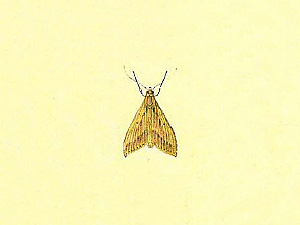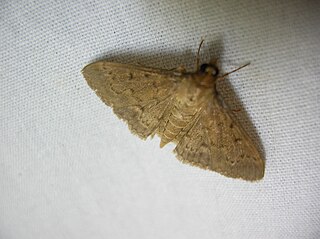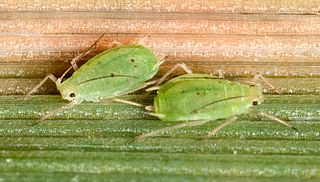
Paspalum is a genus of plants in the grass family.

Omiodes is a moth genus in the family Crambidae. Several species are endemic to Hawaii.
Omiodes fullawayi, Fullaway's banana hedyleptan moth, is a species of moth in the family Crambidae. It was described by Otto Herman Swezey in 1913 and is endemic to the island of Hawaii.

Omiodes telegrapha, the telegraphic hedyleptan moth, is a species of moth in the family Crambidae. It is endemic to the island of Hawaii.

Paspalum scrobiculatum, commonly called kodo millet or koda millet, is an annual grain that is grown primarily in Nepal and also in India, Philippines, Indonesia, Vietnam, Thailand, and in West Africa from where it originated. It is grown as a minor crop in most of these areas, with the exception of the Deccan plateau in India where it is grown as a major food source. It is a very hardy crop that is drought tolerant and can survive on marginal soils where other crops may not survive, and can supply 450–900 kg of grain per hectare. Kodo millet has large potential to provide nourishing food to subsistence farmers in Africa and elsewhere.
Sipha flava is a species of aphid in the family Aphididae. It is native to North America. Its common name is yellow sugarcane aphid.

Omiodes demaratalis, the Hawaiian grass leafroller, is a species of moth in the family Crambidae. It is endemic to the Hawaiian islands of Niihau, Kauai, Oahu, Molokai, Maui and Hawaii.

Omiodes blackburni, the coconut leafroller, is a species of moth in the family Crambidae. It is endemic to the Hawaiian islands of Kauai, Oahu, Molokai, Maui, Lanai and Hawaii. The species was first described by Arthur Gardiner Butler in 1877.

Paspalum dilatatum is a species of grass known by the common name dallisgrass, Dallas grass, or sticky heads. It is native to Brazil and Argentina, but it is known throughout the world as an introduced species and at times a common weed. Its rapid growth and spreading rhizomes make it an invasive pest in some areas. It is present in the southern half of North America, southern Europe, much of Africa, Australia, New Zealand, and many tropical and subtropical areas.

Paspalum distichum is a species of grass. Common names include knotgrass, water finger-grass, couch paspalum, eternity grass, gingergrass, and Thompson grass. Its native range is obscure because it has long been present on most continents, and in most areas it is certainly an introduced species. Its native range probably includes parts of the tropical Americas.

Paspalum urvillei is a species of grass known by the common name Vasey's grass, or Vasey grass. It is native to South America, and it is known in parts of North America as an introduced species. It is also naturalised in Australia, New Zealand, Japan, China, and southern Africa, including Madagascar. It is a noxious weed where it has been introduced in Hawaii and New Caledonia. It grows well in disturbed habitat, often in moist areas. This is a rhizomatous perennial grass which may reach 2 meters tall. The leaves are up to 2.5 centimeters wide and have a large, noticeable ligule. The inflorescence is a spreading or drooping array of up to 20
Mythimna macrosaris is a moth of the family Noctuidae. It was first described by Edward Meyrick in 1899. It is endemic to the Hawaiian islands of Kauai, Oahu, Molokai and Hawaii.
Omiodes anastreptoides is a moth of the family Crambidae. It was described by Otto Herman Swezey in 1913 and is endemic to the island of Hawaii. It was first cited as possibly extinct in 1994 by the U.S. Fish & Wildlife Service. It was listed as extinct by the Hawaiʻi Biological Survey in 2002, but was rediscovered in 2003.

Omiodes localis is a moth of the family Crambidae. It is endemic to the Hawaiian islands of Kauai, Oahu, Molokai, Maui, Lanai and Hawaii.

Paspalum setaceum is a species of grass known by several common names, including thin paspalum. It is native to the Americas, where it can be found in the eastern and central United States, Ontario in Canada, Mexico, Central America, and the Caribbean. It can be found in other areas of the world as an introduced, and often invasive, species, including many Pacific Islands. It is a weed of lawns and turf.

Paspalum vaginatum is a species of grass known by many names, including seashore paspalum, biscuit grass, saltwater couch, silt grass, and swamp couch. It is native to the Americas, where it grows in tropical and subtropical regions. It is found throughout the other tropical areas of the world, where it is an introduced species and sometimes an invasive weed. It is also cultivated as a turfgrass in many places.
Lespesia archippivora is a species of tachinid fly, which, like all tachinids, are parasitoids of other arthropods. L. archippivora lives in the body of its host resulting in its death. This is not uncommon since it is estimated that about 10% of all insects are parasitoids. L. archippivora is a generalist and able to infect at least 25 lepidopteran species in addition to one species of Hymenoptera. It is common in North America and other species exist worldwide. One study suggests the species is bivoltine.

The greenbug, or wheat aphid, is an aphid in the superfamily Aphidoidea in the order Hemiptera. It is a true bug and feeds on the leaves of Gramineae (grass) family members.

Paspalum conjugatum, commonly known as carabao grass or hilo grass, is a tropical to subtropical perennial grass. It is originally from the American tropics, but has been naturalized widely in tropical Southeast Asia and Pacific Islands. It has also spread to Northern Africa and Northern and Eastern Australia. It is also known as sour paspalum, T-grass, or more confusingly, as "buffalo grass" or "sour grass".












